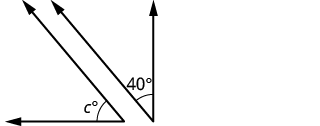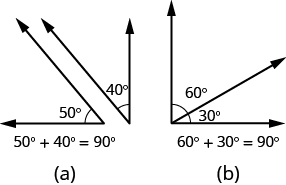Are you familiar with the phrase ‘do a [latex]180\text{'?}[/latex] It means to make a full turn so that you face the opposite direction. It comes from the fact that the measure of an angle that makes a straight line is [latex]180[/latex] degrees. See the image below.
[latex]\angle A[/latex] is the angle with vertex at [latex]\text{point }A[/latex].

example
An angle measures [latex]\text{40}^ \circ[/latex]. Find 1. its supplement, and 2. its complement.
Solution
| 1. |
|
| Step 1. Read the problem. Draw the figure and label it with the given information. |
 |
| Step 2. Identify what you are looking for. |
The supplement of a [latex]40°[/latex]angle. |
| Step 3. Name. Choose a variable to represent it. |
Let [latex]s=[/latex]the measure of the supplement. |
| Step 4. Translate.
Write the appropriate formula for the situation and substitute in the given information. |
[latex]m\angle A+m\angle B=180[/latex]
[latex]s+40=180[/latex] |
| Step 5. Solve the equation. |
[latex]s=140[/latex] |
| Step 6. Check:
[latex-display]140+40\stackrel{?}{=}180[/latex-display]
[latex]180=180\checkmark[/latex] |
|
| Step 7. Answer the question. |
The supplement of the [latex]40°[/latex]angle is [latex]140°[/latex]. |
| 2. |
|
| Step 1. Read the problem. Draw the figure and label it with the given information. |
 |
| Step 2. Identify what you are looking for. |
| The complement of a [latex]40°[/latex]angle. |
|
| Step 3. Name. Choose a variable to represent it. |
Let [latex]c=[/latex]the measure of the complement. |
| Step 4. Translate.
Write the appropriate formula for the situation and substitute in the given information. |
[latex]m\angle A+m\angle B=90[/latex] |
| Step 5. Solve the equation. |
[latex]c+40=90[/latex]
[latex]c=50[/latex] |
| Step 6. Check:
[latex-display]50+40\stackrel{?}{=}90[/latex-display]
[latex]90=90\quad\checkmark[/latex] |
|
| Step 7. Answer the question. |
The complement of the [latex]40°[/latex]angle is [latex]50°[/latex]. |
Exercises
Two angles are supplementary. The larger angle is [latex]\text{30}^ \circ[/latex] more than the smaller angle. Find the measure of both angles.
Answer:
Solution:
| Step 1. Read the problem. Draw the figure and label it with the given information. |
 |
| Step 2. Identify what you are looking for. |
The measures of both angles. |
| Step 3. Name. Choose a variable to represent it.
The larger angle is 30° more than the smaller angle. |
Let [latex]a=[/latex] measure of smaller angle
[latex]a+30=[/latex] measure of larger angle |
| Step 4. Translate.
Write the appropriate formula and substitute. |
[latex]m\angle A+m\angle B=180[/latex] |
| Step 5. Solve the equation. |
[latex](a+30)+a=180[/latex]
[latex-display]2a+30=180[/latex-display]
[latex-display]2a=150[/latex-display]
[latex]a=75[/latex]measure of smaller angle.
[latex]a+30[/latex]measure of larger angle.
[latex-display]75+30[/latex-display]
[latex]105[/latex] |
| Step 6. Check:
[latex-display]m\angle A+m\angle B=180[/latex-display]
[latex-display]75+105\stackrel{?}{=}180[/latex-display]
[latex]180=180\quad\checkmark[/latex] |
|
| Step 7. Answer the question. |
The measures of the angle are [latex]75°[/latex]and [latex]105°[/latex]. |
 An angle is formed by two rays that share a common endpoint. Each ray is called a side of the angle and the common endpoint is called the vertex. An angle is named by its vertex. In the image below, [latex]\angle A[/latex] is the angle with vertex at point [latex]A[/latex]. The measure of [latex]\angle A[/latex] is written [latex]m\angle A[/latex].
An angle is formed by two rays that share a common endpoint. Each ray is called a side of the angle and the common endpoint is called the vertex. An angle is named by its vertex. In the image below, [latex]\angle A[/latex] is the angle with vertex at point [latex]A[/latex]. The measure of [latex]\angle A[/latex] is written [latex]m\angle A[/latex].


 If the sum of the measures of two angles is [latex]\text{90}^ \circ[/latex], then the angles are complementary angles. In the images below, each pair of angles is complementary, because their measures add to [latex]\text{90}^ \circ[/latex]. Each angle is the complement of the other.
The sum of the measures of complementary angles is [latex]\text{90}^ \circ[/latex].
If the sum of the measures of two angles is [latex]\text{90}^ \circ[/latex], then the angles are complementary angles. In the images below, each pair of angles is complementary, because their measures add to [latex]\text{90}^ \circ[/latex]. Each angle is the complement of the other.
The sum of the measures of complementary angles is [latex]\text{90}^ \circ[/latex].




